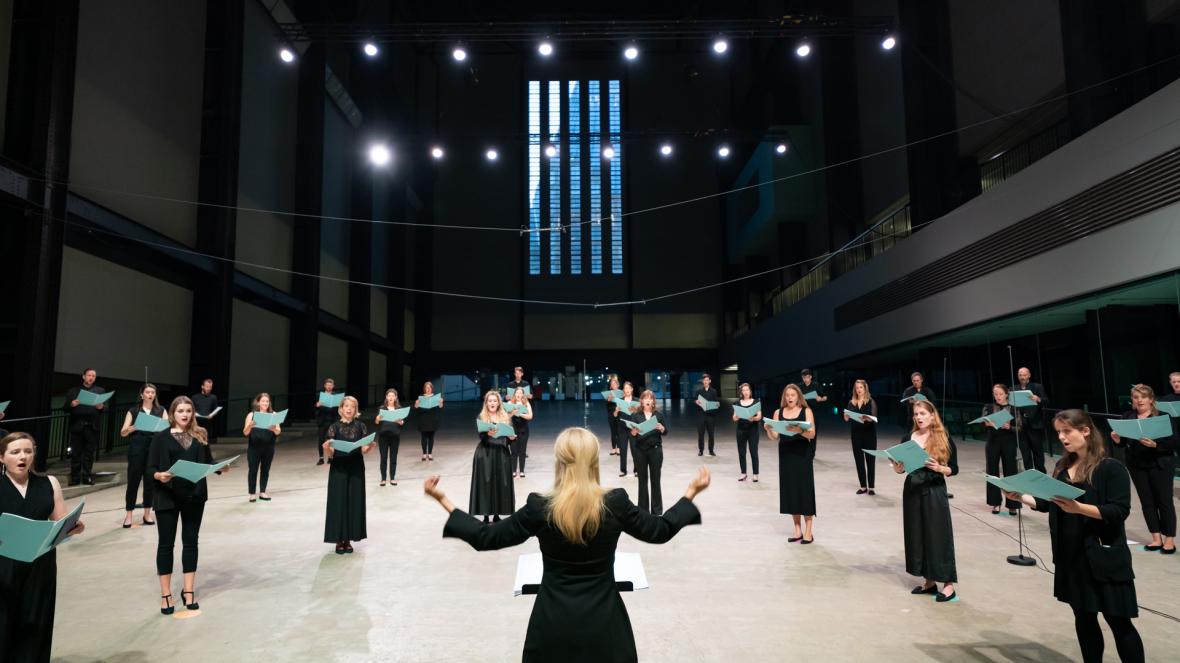It’s the breath I miss most. The moment when a shuffling group of men and women in scruffy concert blacks breathe in as one and become an ensemble. Now that our breath is diseased, shrunk from, masked, now that performances are digitally distanced and filtered, smoothed and flattened out on screens, there’s something dangerously poignant about that physical swell of inhalation and exhalation that sets the air in motion at the front of a concert hall.
Which is why, when I heard that 40 singers would be coming together in Tate Modern’s Turbine Hall to sing Thomas Tallis’s Spem in alium, I twitched with need to be there.
We talk a lot about size with Spem (and not just since it made a cameo appearance in Christian Grey’s Red Room of Pain in Fifty Shades of Grey), get hung up on the 40 parts that make it one of the biggest works of its kind. But, as Grey would argue, it’s what you do with it that counts. Spem isn’t about a monolithic wall of sound, it’s about the movement of sound through space — three-dimensional music.
It was the refusal to be silenced and separated that hit hard. I don’t know when I’ve been more moved
Eight choirs of five voices fan out in a horseshoe allowing an audience to follow melodies as they move gradually around the room from Choir I to Choir VIII and back again. It’s 16th-century surround sound: renaissance architecture as intricate and magnificent as Nonsuch Palace, where it was probably performed, but which lives only in the moment of its creation, built out of breath and air.
In the end I couldn’t be there; no one could. The Tate’s hyper-vigilance (if you can’t social distance in the Turbine Hall, where can you?) banished the audience to our laptops. It wasn’t the same, but it was something. Watching the Ora Singers and music director Suzi Digby — many singing with colleagues for the first time in six months — filling the space with sound was a reminder of the work’s defiant ambition.
The text praises God, but everything about the setting celebrates man. Those monumental moments where all the voices come together at last: ‘respice humilitatem nostrum’. Look upon our humility. Nothing says humble quite like a 40-part shout of command. In this moment it was an against-the-odds gesture, a refusal to be silenced and separated, that hit hard. I don’t know when I’ve been more moved.
It costs a lot to make this kind of epic simplicity, to light the Turbine Hall, hire a camera crew and sound team as well as a choir, to commission a new companion piece (also in 40 parts) from James MacMillan. Increasingly few will be able to afford it, particularly with a growing expectation of free content. It’s no coincidence that the big brands — the Royal Opera, Southbank Centre, Barbican — have stayed sonorously quiet through lockdown, letting smaller organisations experiment and lead the way with risky live ventures.
When Tallis wasn’t composing vast, patron-pleasing motets for royal propaganda, the recusant Catholic was creating rather different works. Many of his Latin motets and masses are the whispered prayers of illegal congregations, gathered in secret. As live performances return quietly, cautiously, these simpler pieces speak to our situation — music you could (at least in theory) stumble through around the piano with your five permitted friends.
But if you’d still rather hear the pros do it, you could do a lot worse than explore the newly formed Hampstead Collective’s Start the Week series. Hosted by Hampstead Parish Church every Monday night, and running through to Christmas, these small-forces recitals are a chance to get back in the room (though internet streaming is also available) for spiritual music from Tallis to Hildegard of Bingen, Bach and even Handel’s oratorio Theodora.
The core of performers come from the church’s talented young choir — musicians usually working with the big ensembles, but now creating their own chamber series. There’s a makeshift quality to the concerts: Bach cantatas arranged for string quartet and oboes, chamber organ standing in for whole orchestras where necessary. Forced into newly creative pragmatism, the results are exactly the kind of unfiltered music-making — sometimes rough, sometimes electrifying — we’re missing in the current glut of glossy, here’s-one-we-made-earlier archive performances.
I defy anyone to watch the group’s ‘When Two or Three Are Gathered Together’ programme, to hear Tallis’s Mass for Three Voices performed by contralto Jess Dandy, tenor Aidan Coburn and bass Ben McKee with all the urgency of singers who haven’t been allowed to sing for months, and not feel something of the work’s original illicit charge. The sensitivity (bordering on sensuality) of phrasing that delights in the counterpoint’s snatched moments of intimacy, the human colour of voices who sing as individuals, not as an anonymous unit, and of course the shared breath that binds them together — it’s a high beyond high-definition, a conspiracy between performers and audience no technology can replicate.






Comments